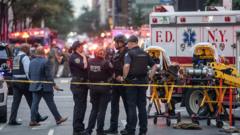On a July evening in Manhattan, a bustling workday abruptly turned to chaos as gunfire erupted at 345 Park Avenue, an iconic skyscraper housing prominent corporate offices, including the National Football League (NFL). The unforeseen violence transformed a typical summer day into a harrowing experience for employees and onlookers alike, compelling some to send poignant farewell texts to loved ones.
The incident began around 6:30 PM when a 27-year-old man, Shane Tamura, arrived in the city after a lengthy road trip from Las Vegas. After parking his vehicle, he approached the entrance of the skyscraper armed with an assault-style rifle. Without hesitation, Tamura opened fire in the lobby, tragically claiming the lives of four people, which included New York police officer Didarul Islam.
As employees scrambled to find safe spaces within the building, the chaos rippled outward, with some resorting to barricading themselves in conference rooms. Jessica Chen, who was in an adjacent area, recalled the moment in sheer fear, stating that she had sent her family messages expressing her love, unsure of her fate.
In an attempt to take control of the massacre, a security officer unsuccessfully sought to activate an alarm system to manage the elevators; unfortunately, he was also killed in the onslaught. As Tamura waited for an elevator, his intentions were thwarted when he mistakenly boarded the wrong one, ending up on the 33rd floor instead of the NFL offices.
In the wake of the attack, frantic emails circulated among employees warning of the shooter, prompting those inside the NFL offices to remain hidden until law enforcement assured their safety. Outside, witnesses reported seeing individuals emerging from the building, hands raised in surrender as they fled the scene.
Amidst the chaos, Tamura took his own life after committing the attack. Authorities later discovered a note on his body expressing his struggles with chronic traumatic encephalopathy (CTE), a condition he reportedly blamed on the NFL—a notion reportedly suggested in his rambling three-page letter.
As investigations continue, the tragic events left behind haunting questions surrounding building security measures, mental health awareness, and the persistent issue of gun violence in the United States.



















